
 Image: IDG / Matthew Smith
Image: IDG / Matthew Smith
At a glance
Expert’s Rating
Pros
Easy to custom, upgrade, or repairWell-rounded CPU and GPU performanceGood battery life for a laptop with discrete graphicsTop-notch connectivity, USB-C with 240 watts of Power Delivery
Cons
Mediocre keyboard and small touchpadDisplay quality falls behind OLED and Mini-LED peersA bit expensive for the hardware provided
Our Verdict
The Framework Laptop 16 delivers strong performance and good battery life alongside a unique blend of customization and repairability.
Price When Reviewed
$2,400
Best Prices Today: Framework Laptop 16 (2024)
RetailerPriceFramework$2400View DealPrice comparison from over 24,000 stores worldwideProductPricePrice comparison from Backmarket
The Framework Laptop 16 is a laptop with a mission. It wants to prove a large, powerful laptop can deliver great performance alongside a repairability that puts other laptops to shame. The Laptop 16 delivers on that promise if you’re willing to pay a premium. Let’s dive right in.
Looking for more options? Check out PCWorld’s roundup of the best laptops.
Framework Laptop 16 (2024): Specs and features
The Framework Laptop 16 I received for review was the DIY Edition, which meant some assembly was required. The memory, storage, ports, and expansion bay are configurable. Shoppers can buy their own memory and storage separately, but the ports (which Framework calls Expansion Cards) and the Expansion Bay must be purchased from Framework since they are designed for its laptops.
CPU: AMD Ryzen 9 7940HSMemory: 32GB LPDDR5 Graphics/GPU: AMD Radeon RX 7700S (in Expansion Bay)Display: 2560×1600 165Hz IPSStorage: 2TB PCIe Gen4 NVMe solid state driveWebcam: 1080p 60fpsConnectivity: Configurable, six expansion cards totalNetworking: Wi-Fi 6E, Bluetooth 5.2, ConfigurableBiometrics: Fingerprint readerBattery capacity: 85 watt-hoursDimensions: 14.04 x 11.42 x 0.82 inchesWeight: 5.29 poundsMSRP: Starts at $1,399, approximately $2,400 as-tested
The DIY Edition offers a long list of options for configuring the laptop. I configured it with the Radeon RX 7700S GPU (Radeon 780M integrated graphics are available) and installed a total of six ports: two USB-C, two USB-A, DisplayPort-out and 3.5mm combo audio. Framework also included Expansion Cards for other ports including HDMI and Ethernet, but I decided not to use them.
Framework Laptop 16 (2024): Design and build quality
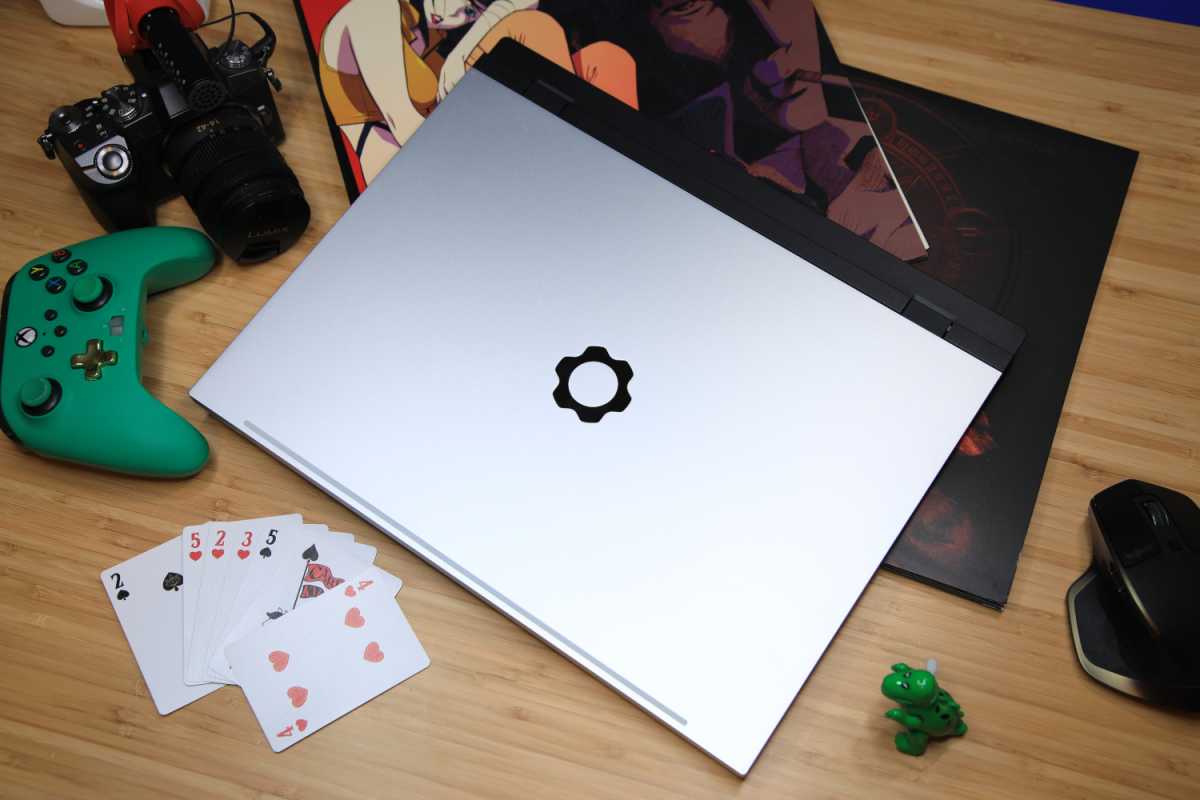
IDG / Matthew Smith
IDG / Matthew Smith
IDG / Matthew Smith
Unboxing the Framework Laptop 16 DIY Edition is a far different experience than a usual laptop. The DIY Edition is not fully assembled but instead a kit with at least most of the pieces you’ll need to build it (you can buy memory and storage from Framework or purchase it separately). Instructions for assembly are available online and a screwdriver, which is necessary to access some internal components, is included.
Customization, upgradability, and repairability are key points for Framework, and the Laptop 16’s design embraces these ideas. Many configurable components (including the keyboard, numpad, macropad, LED matrix lights, and ports) can be swapped without tools and even while the laptop is turned on. Only the memory, storage, and Expansion Bay require use of the screwdriver and should be serviced with the laptop off. The DIY Edition also requires an operating system, which isn’t provided (I used Windows 11).
I had the Framework Laptop 16 DIY Edition up and running in less than two hours. Framework’s instructions were both detailed and clear, which should make setup simple even if you haven’t tinkered with PC hardware before. With that said, though, working on expensive hardware can prove intimidating. Framework also sells pre-assembled laptops for those leery about rolling their own.
Once assembled, the Framework Laptop 16 is an attractive, if not especially slim, machine. It opts for a classic look with relatively thick bezels and a silver metal exterior, but good material quality elevates the design and keeps panel flex to a minimum. The laptop’s 5.29 pounds of heft is towards the high end for a modern 16-inch laptop, and the same can be said of its depth and width, so portability isn’t a strength.
Framework Laptop 16 (2024): Keyboard, trackpad
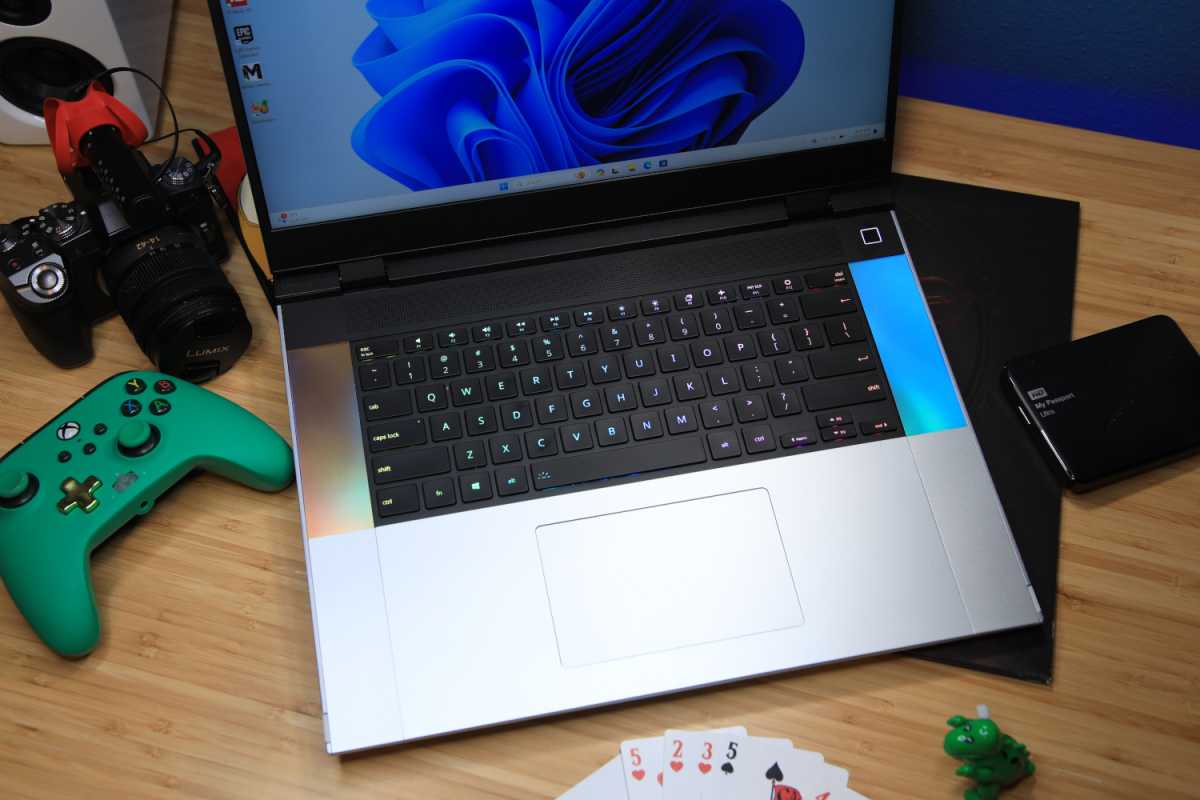
IDG / Matthew Smith
IDG / Matthew Smith
IDG / Matthew Smith
The Framework Laptop 16’s focus of customization really comes across with the keyboard. Framework offers multiple keyboards for various languages and preferences (I received the US English, RGB-backlit keyboard). Owners can choose to add a numpad or macropad, or neither, as desired. It’s also simple to remove or add the numpad as it’s needed, so those who only sometimes need a numpad can remove it when it’s unwanted.
I set up the Framework Laptop 16 without a numpad and instead centered the keyboard with a blank spacer on each side. The spacers are available in a variety of colors to spice up the laptop’s look. Framework also offers an LED Matrix spacer that can be configured to display notifications or text.
Key feel is just ok, however. The keyboard has reasonable key travel and a firm bottoming action, but key actuation lacks tactile feel and keyboard flex is significant in the middle of the keyboard. Don’t get me wrong: when I say it’s ok, I mean it’s ok. I typed several thousands words with no issue. Still, it might help if Framework could find a way to reinforce the center of the keyboard. I’d also love to see an optional keyboard with mechanical switches.
The touchpad sadly lacks the keyboard’s customization. It measures a tad less than five inches wide and about three inches deep, which is on the small side for a modern 16-inch laptop. It’s a responsive, enjoyable touchpad, but the lack of physical space can make it feel a bit cramped when performing multi-touch gestures.
Framework Laptop 16 (2024): Display, audio
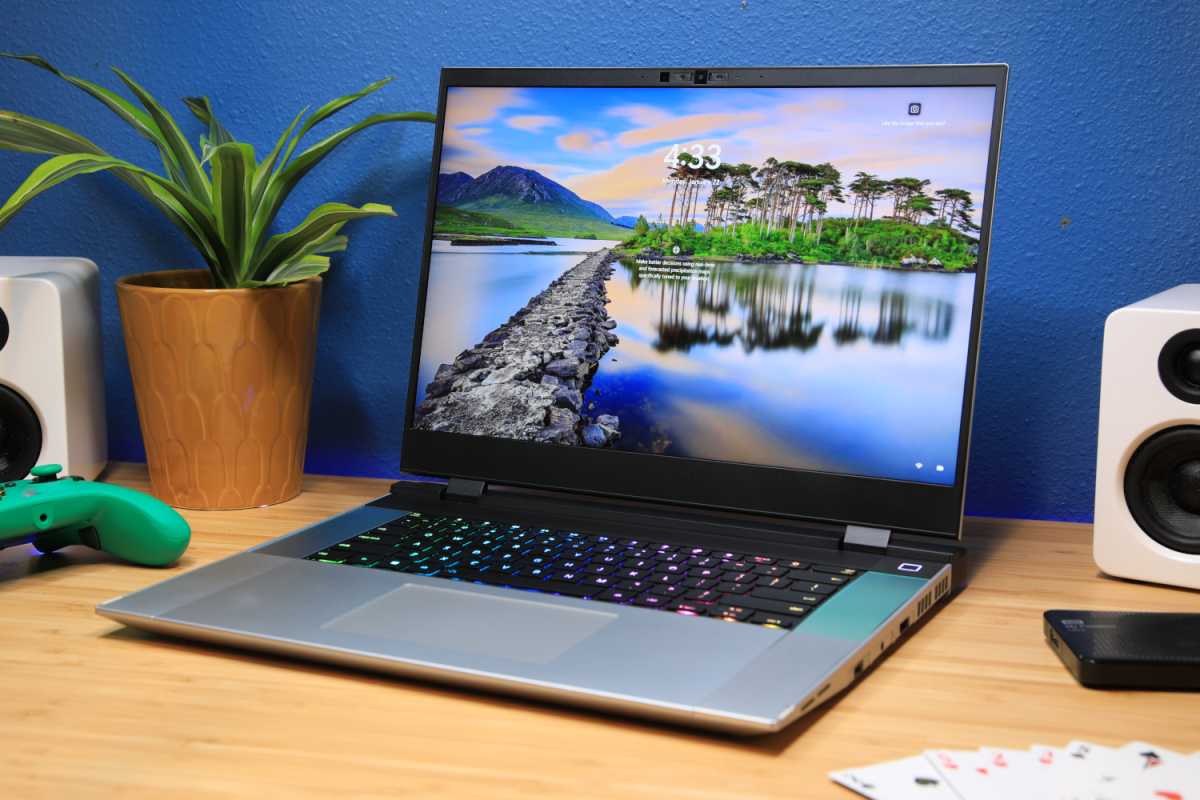
IDG / Matthew Smith
IDG / Matthew Smith
IDG / Matthew Smith
Every Framework Laptop 16 has the same 16-inch, 2560×1600, 165Hz display with an IPS panel. This is one aspect of the laptop that’s not customizable, though it is designed to be replaced should it break (parts will be available through Framework).
I’ll start with the obvious criticism: this is a basic display for an expensive laptop sold in 2024. It doesn’t have 4K resolution, an OLED panel, or a dynamic Mini-LED backlight. Image quality is good, but lacks the depth and immersion found in OLED and Mini-LED competitors. TV shows, movies, and games look less vibrant than on price-competitive laptops like the Asus Vivobook Pro 16X OLED.
But it’s not all bad news.
Sticking to an IPS display provides an advantage in clarity and brightness. The Laptop 16’s display panel has a matte coat that reduces glare and its resolution, though not groundbreaking, remains high enough to deliver excellent sharpness at a typical viewing distance. It’s a great display for viewing and editing documents, spreadsheets, and PDFs.
Motion clarity is good too thanks to the display’s 165Hz refresh rate. Higher fresh rates are available (a few laptops reach up to 480Hz), but 165Hz is a good fit for the hardware. Compared to a 60Hz refresh rate, it delivers a boost in clarity both in games and on the desktop.
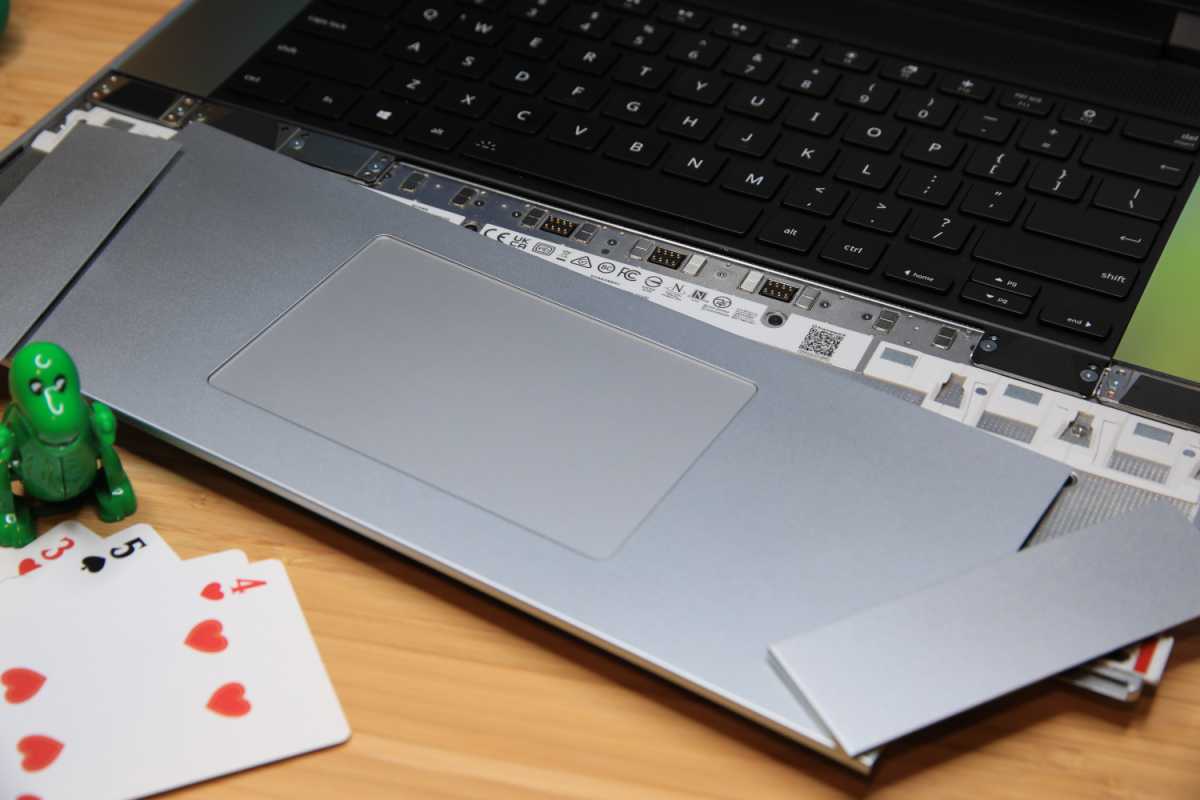
IDG / Matthew Smith
IDG / Matthew Smith
IDG / Matthew Smith
Audio quality is strong. The Framework 16 has upwards-firing speakers, which is a plus, as it means the audio is never muffled or distorted by the surface the laptop is placed on. Maximum volume is just mediocre, but the presentation is pleasant. Bass and treble co-exists without one demolishing the other. The result is crisp audio that’s great for casually listening to Spotify and works well enough for most Netflix shows.
Framework Laptop 16 (2024): Webcam, microphone, biometrics
The Framework Laptop 16 has a 1080p, 60fps webcam with a dual microphone array. Video quality is good with a sharp presentation and modest noise (for a laptop webcam), although colors are subdued. The microphones, meanwhile, picked up clear audio with good volume. It’s a solid combination for Zoom, Google Hangouts, and other video conferencing software.
Privacy-conscious users will be happy to hear the laptop has a deactivation switch for both the camera and the microphone. They are electronic, however, so the camera and microphone remain physically unobstructed.
Biometric login is provided through a fingerprint reader in the laptop’s power button. It works as well as any other I’ve tried. Fingerprint reading is usually reliable but quickly fooled by grime or moisture. Framework offers Linux drivers for the fingerprint reading, so it will function in that operating system as well as in Windows.

IDG / Matthew Smith
IDG / Matthew Smith
IDG / Matthew Smith
Framework Laptop 16 (2024): Connectivity
The Framework Laptop 16’s connectivity is unlike any laptop available today (aside from Framework’s other laptops, of course). Its connectivity is not fixed but configurable through Expansion Card slots. There’s three on each side of the laptop for a total of six.
These slots can be fitted with any port from the following list: HDMI, DisplayPort, USB-C, USB-A, 3.5mm audio, Ethernet, or a MicroSD card reader. You can mix and match as you’d desire, though Framework strongly recommends choosing at least one USB-C port (since that is how the laptop is charged).
Speaking of USB-C, the Framework Laptop 16 supports DisplayPort Alternate Mode and up to 240 watts of power delivery over USB-C. That’s excellent, since it means the laptop can be fully powered by any USB-C adapter of sufficient capacity. The Graphics Module with AMD Radeon RX 7700S graphics adds an additional USB-C port with DisplayPort Alternate Mode, but it doesn’t support USB-C charging.
The Framework Laptop 16 ships with an AMD-provided Wi-Fi 6E card and Bluetooth 5.2. The Wi-Fi adapter, like so much of the laptop, can be accessed and replaced if needed. I doubt most users will see much reason, however, as AMD’s Wi-Fi adapter was reliable in my time with the laptop.
Framework Laptop 16 (2024): Performance
The Framework Laptop 16’s internals are intriguing, and not just because they’re so easy to repair or replace. The model I tested has an AMD Ryzen 7 7940HS processor which, if the optional graphics Expansion Bay is purchased, is paired with AMD Radeon RX 7700S graphics (if not, the integrated Radeon RX 780M is used). It’s important to note the Ryzen 7 7940HS is an upgrade: the entry-level model has AMD’s Ryzen 7 7840HS.
Laptops that go AMD for both the CPU and GPU remain rare in 2024. Let’s see how it stacks up.
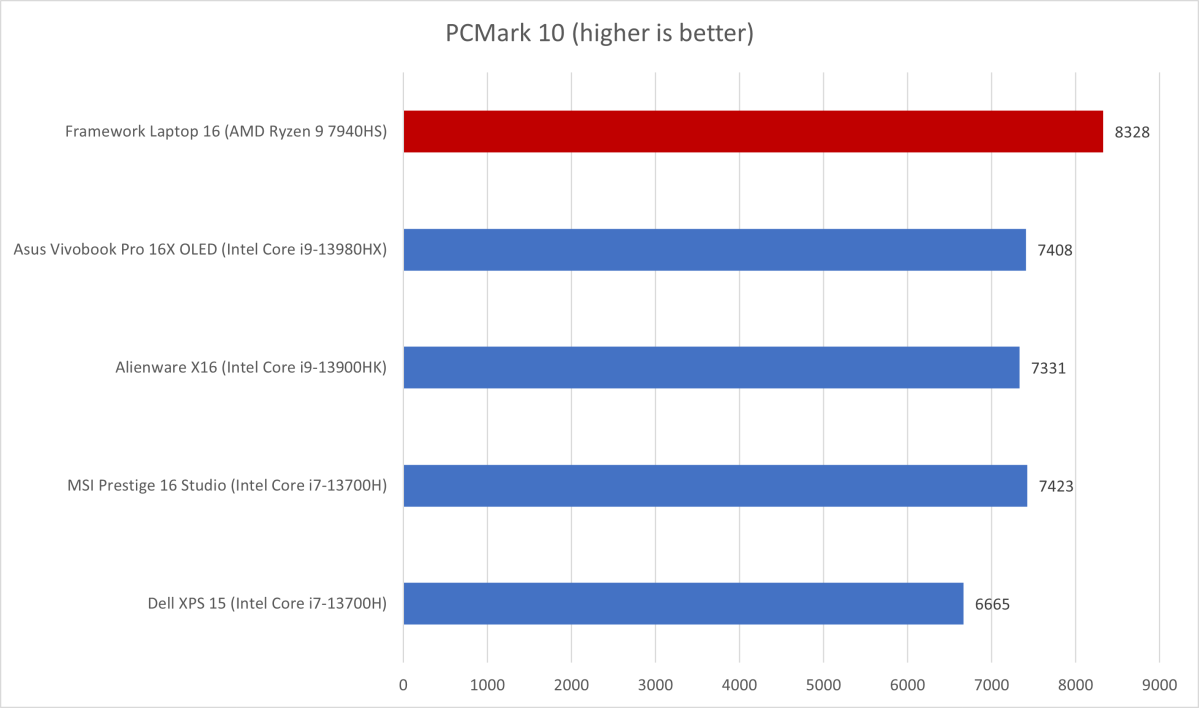
IDG / Matthew Smith
IDG / Matthew Smith
IDG / Matthew Smith
PCMark 10 puts the Framework Laptop 16 off to a stellar start with a striking score of 8,328. That’s by far the best of the laptops I chose for comparison. It’s even competitive with some laptops in a higher price bracket like the Asus ROG Strix Scar 18.
The Framework Laptop 16’s performance is good thanks to the well-rounded configuration I received to test. PCMark 10 tests both CPU and GPU. It also seems to prefer a large amount of memory, and the Laptop 16 I tested had 32GB equipped.
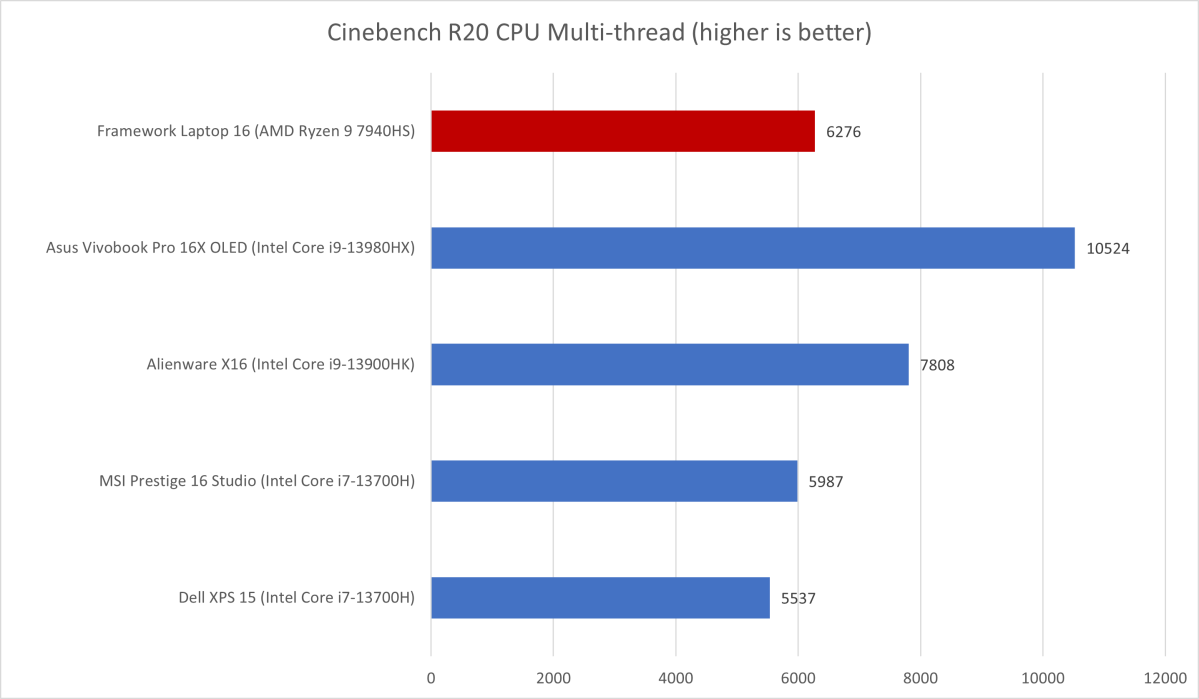
IDG / Matthew Smith
IDG / Matthew Smith
IDG / Matthew Smith
Cinebench R20, a heavily multi-threaded CPU benchmark with a short duration, is less kind to the Framework Laptop 16. The Ryzen 9 7940HS falls back from the head of the pack. However, it’s competitive with some Intel Core i7 laptops with more stringent power budgets such as the MSI Prestige 16 Studio.
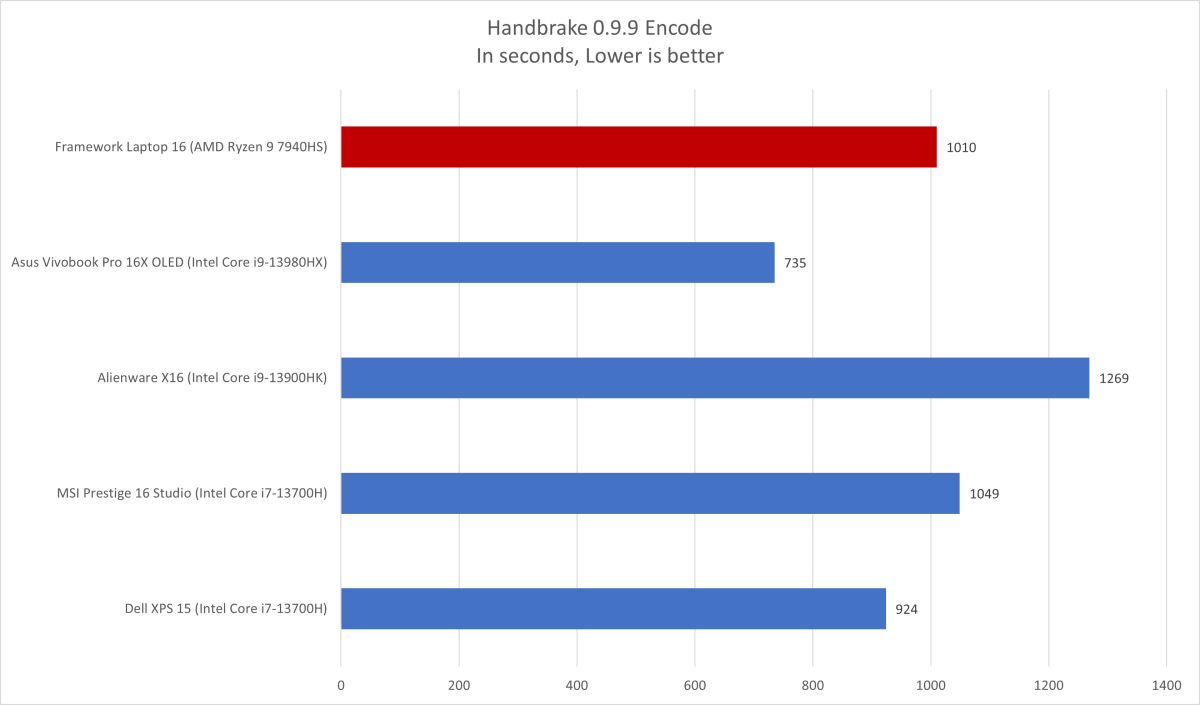
IDG / Matthew Smith
IDG / Matthew Smith
IDG / Matthew Smith
It’s a similar story in Handbrake, a long-duration CPU benchmark. Here, the Ryzen 9 7940HS once again turns in a healthy but average result. It runs ahead of the MSI Prestige 16 Studio but falls behind the Asus Vivobook Pro 16X OLED.
Now it’s time to give the GPU some exercise. AMD’s Radeon 7700S is a mid-tier GPU with 8GB of graphics memory that’s meant to compete with Nvidia’s RTX 4060—and that’s exactly where it lands.
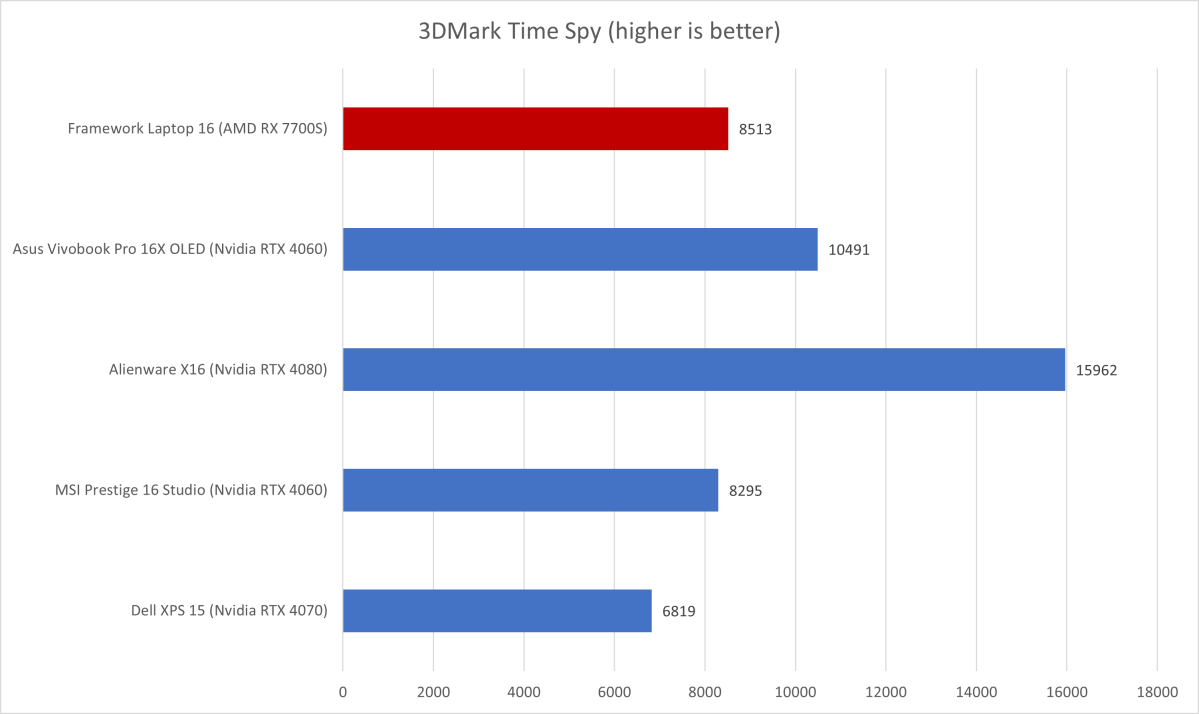
IDG / Matthew Smith
IDG / Matthew Smith
IDG / Matthew Smith
3DMark Time Spy reported a score of 8,513. That puts the Framework Laptop 16 behind some RTX 4060 laptops like the Asus Vivobook Pro 16X OLED, but ahead of others like the MSI Prestige 16 Studio.
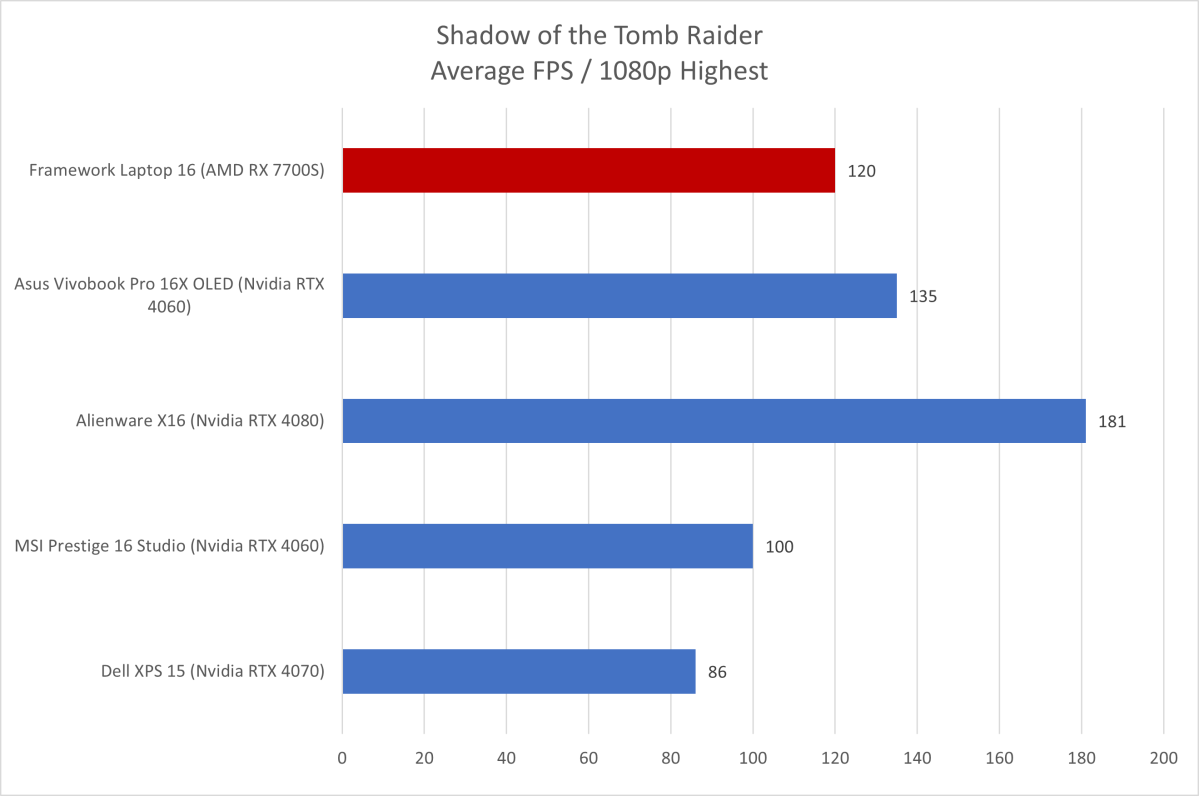
IDG / Matthew Smith
IDG / Matthew Smith
IDG / Matthew Smith
Shadow of the Tomb Raider, a demanding game from the PlayStation 4 and Xbox One console generation, shows what the RX 7700S can do. It achieved an average of 120 frames per second at 1080p resolution with detail set to Highest. That’s an extremely playable result, of course, and once again puts the Framework Laptop 16 in league with laptops that have Nvidia RTX 4060 graphics.
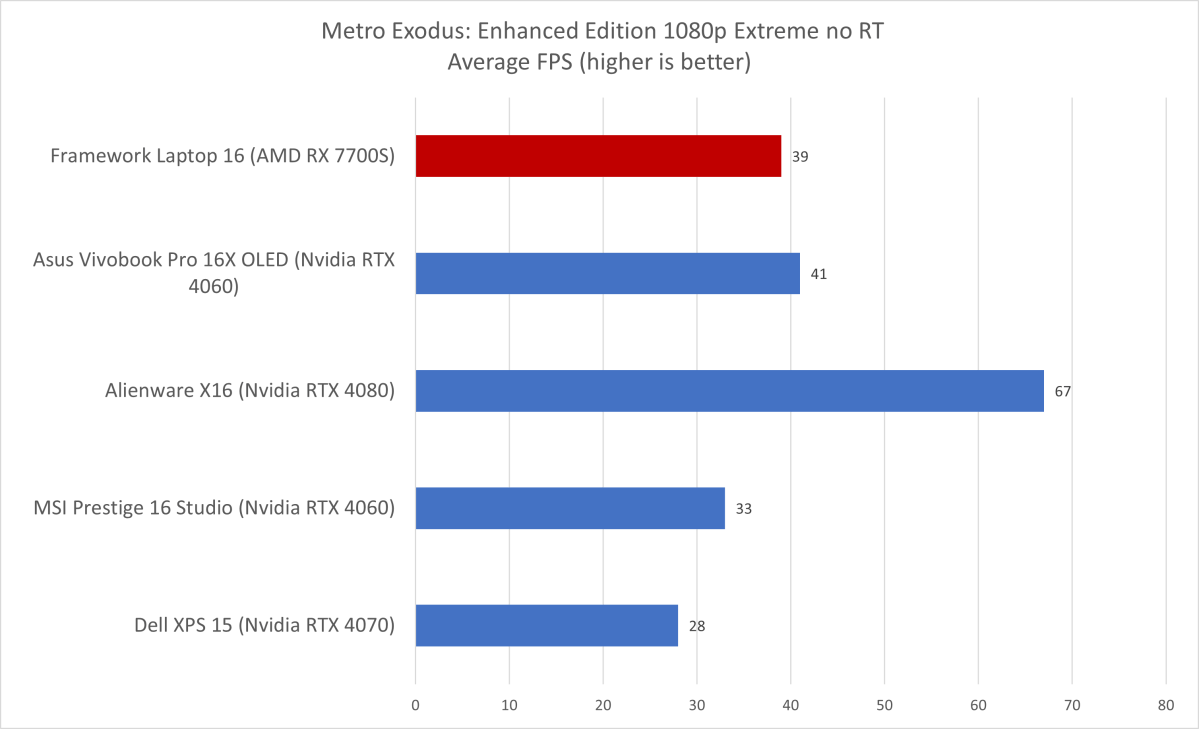
IDG / Matthew Smith
IDG / Matthew Smith
IDG / Matthew Smith
Metro Exodus is a more demanding benchmark, at least when tested at Extreme settings, but even it proves playable with an average of 39 frames per second. That’s quite good for a laptop that doesn’t explicitly promise great game performance and it puts the Framework Laptop 16 just a smidge behind the Asus Vivobook Pro 16X OLED.
The Framework Laptop 16’s overall performance is what I would expect from a 16-inch laptop in its price bracket and it doesn’t over or under-perform in any single test. Keep in mind, however, that nearly all laptops in the Laptop 16’s price and performance bracket are quick and will deliver a healthy boost over any similar laptop that’s now more than several years old. The Laptop 16’s can handle a wide variety of content creation and entertainment tasks.
Framework Laptop 16 (2024): Battery life
The Framework 16 laptop has a 85 watt-hour battery which, like so much of the laptop, is easy to access and replace (but can’t be customized). It’s not the largest battery possible in a 16-inch laptop, but that doesn’t hold battery life back.

IDG / Matthew Smith
IDG / Matthew Smith
IDG / Matthew Smith
I saw nine hours and 36 minutes of battery life in our standard battery test, which loops a 4K file of the short film Tears of Steel with the display calibrated to approximately 200 nits.
That’s not a recording-breaking result, but it’s great for a Windows laptop with discrete graphics. A lot of credit no doubt goes to AMD’s switchable graphics, which reverts to the more power-efficient integrated Radeon 780M APU when the discrete GPU is not required.
Framework Laptop 16 (2024): Pre-production issues
I encountered two minor, but potentially annoying issues with the pre-production laptop I received to test. The laptop produced odd noises, especially when the GPU was engaged. A Framework representative told me it is aware of two noise issues: one due to an “incorrect capacitor value,” the other “related to the inductors.”
A Framework representative told me both issues “have been corrected on customer units.”
Framework Laptop 16 (2024): Conclusion
The Framework Laptop 16 is the best evidence yet that modern laptops can deliver customization, repairability, and performance in one package. It offers solid benchmark results, good battery life, and robust design. That’s not to say it’s perfect: the keyboard is just ok, the touchpad could be larger, and the display’s image quality is mediocre. But the laptop balances those disadvantages with other perks like strong audio performance and configurable connectivity that includes USB-C with up to 240 watts of power delivery,
There’s just one wrinkle, and that’s the price. Though it starts at $1,400, my as-tested configuration rang up closer to $2,400 (or around $2,600 if you purchase the pre-built model). That’s not an unreasonable price for a laptop with the Framework Laptop 16’s performance, but it’s closer to the Razer Blade 16 than the Asus Vivobook Pro 16X OLED. Framework won’t make sense if you don’t want to upgrade or repair your laptop. But if you (like me) don’t mind tinkering, it’s well worth the price.
Best Prices Today: Framework Laptop 16 (2024)
RetailerPriceFramework$2400View DealPrice comparison from over 24,000 stores worldwideProductPricePrice comparison from Backmarket
Author: Matthew S. Smith
Matthew S. Smith is a freelance technology journalist with 15 years of experience reviewing consumer electronics. In addition to PCWorld, his work can be found on Wired, Ars Technica, Digital Trends, Reviewed, IGN, and Lifewire. Matthew also covers AI and the metaverse for IEEE Spectrum and runs Computer Gaming Yesterday, a YouTube channel devoted to PC gaming history.
Recent stories by Matthew S. Smith:
Acer Predator Helios Neo 18 review: A huge gaming laptop for a small priceAcer Chromebook 516 GE review: A cloud gaming powerhouseAsus Zenbook 14 OLED review: A budget laptop star


